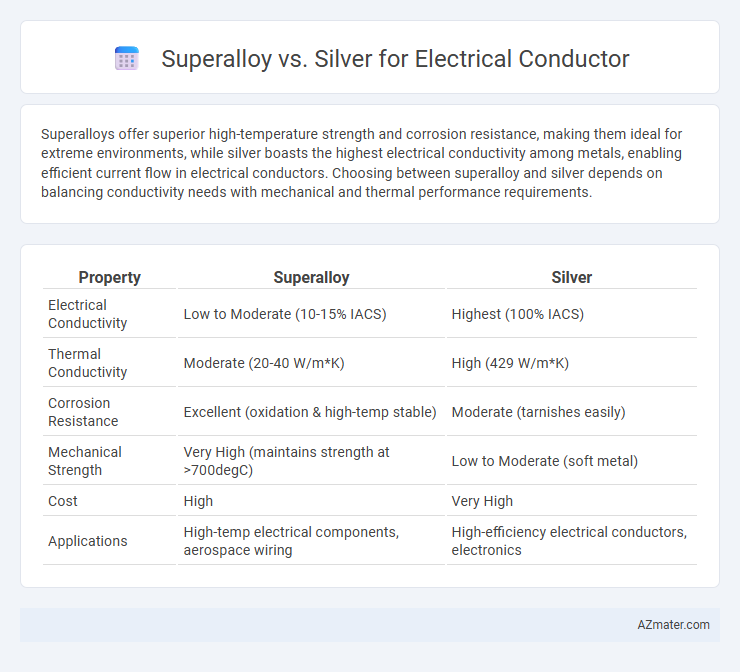Superalloys offer superior high-temperature strength and corrosion resistance, making them ideal for extreme environments, while silver boasts the highest electrical conductivity among metals, enabling efficient current flow in electrical conductors. Choosing between superalloy and silver depends on balancing conductivity needs with mechanical and thermal performance requirements.
Table of Comparison
| Property | Superalloy | Silver |
|---|---|---|
| Electrical Conductivity | Low to Moderate (10-15% IACS) | Highest (100% IACS) |
| Thermal Conductivity | Moderate (20-40 W/m*K) | High (429 W/m*K) |
| Corrosion Resistance | Excellent (oxidation & high-temp stable) | Moderate (tarnishes easily) |
| Mechanical Strength | Very High (maintains strength at >700degC) | Low to Moderate (soft metal) |
| Cost | High | Very High |
| Applications | High-temp electrical components, aerospace wiring | High-efficiency electrical conductors, electronics |
Introduction: Comparing Superalloy and Silver as Electrical Conductors
Superalloys, composed primarily of nickel, cobalt, and iron, offer exceptional mechanical strength and corrosion resistance, making them suitable for high-temperature electrical conductor applications. Silver, renowned for its outstanding electrical conductivity, provides superior performance in minimizing electrical resistance and energy loss. Comparing their electrical conductivity values, silver excels with approximately 6.3 x 10^7 S/m, whereas superalloys typically exhibit much lower conductivity around 1 x 10^6 to 1 x 10^7 S/m, highlighting the trade-off between conductivity and mechanical durability.
Material Composition and Structure
Superalloys, typically composed of nickel, cobalt, and iron-based elements with additions like chromium and aluminum, feature a complex microstructure designed for high strength and corrosion resistance at elevated temperatures. Silver, a pure elemental metal with a face-centered cubic crystal structure, offers the highest electrical conductivity among metals but lacks the mechanical strength and thermal stability of superalloys. The difference in material composition and crystalline structure results in superalloys providing superior durability in harsh environments, while silver excels in electrical conduction efficiency under standard conditions.
Electrical Conductivity: Superalloy vs Silver
Silver exhibits the highest electrical conductivity among all metals, approximately 63 x 10^6 S/m, making it the superior choice for electrical conductors where minimal resistance and efficient current flow are critical. Superalloys, primarily designed for mechanical strength and corrosion resistance at high temperatures, typically have significantly lower conductivity, often less than 5 x 10^6 S/m, which limits their effectiveness in electrical conduction applications. The substantial conductivity difference highlights silver's dominance in applications demanding optimal electrical performance, whereas superalloys are preferred for structural and thermal stability under extreme conditions.
Thermal Stability and Heat Resistance
Superalloys exhibit superior thermal stability and heat resistance compared to silver, maintaining structural integrity and electrical performance at temperatures exceeding 700degC, whereas silver's conductivity diminishes significantly above 200degC due to softening and oxidation. The high melting point of superalloys, often above 1300degC, ensures minimal deformation and oxidation in extreme thermal environments, making them ideal for aerospace and industrial electrical conductors exposed to intense heat. Silver, despite its excellent room-temperature conductivity, is less suitable for high-temperature applications due to its lower thermal threshold and susceptibility to thermal degradation.
Corrosion Resistance and Longevity
Superalloys exhibit superior corrosion resistance compared to silver, making them more durable in harsh environments such as high-temperature or chemically aggressive conditions. Silver offers excellent electrical conductivity but is prone to tarnishing and corrosion, which can reduce longevity in applications exposed to moisture or sulfides. Selecting superalloys for electrical conductors enhances lifespan and reliability by maintaining structural integrity and conductivity over time.
Mechanical Strength and Durability
Superalloys exhibit superior mechanical strength compared to silver, making them highly resistant to deformation and wear under extreme conditions. Their enhanced durability ensures prolonged performance in environments with high temperatures and mechanical stress, outlasting silver conductors that can soften and degrade over time. While silver offers excellent electrical conductivity, superalloys provide an optimal balance of conductivity and long-term mechanical stability in demanding applications.
Cost and Economic Viability
Superalloys, known for their high strength and corrosion resistance, generally have higher initial costs compared to silver when used as electrical conductors. Silver offers exceptional electrical conductivity but suffers from high material costs and potential price volatility, impacting economic viability for large-scale applications. Considering cost-effectiveness, superalloys present a durable alternative in high-temperature environments, while silver remains preferred for applications prioritizing maximum conductivity despite its expense.
Applications in Modern Electronics
Silver offers superior electrical conductivity, making it ideal for high-performance electronic components such as printed circuit boards and connectors found in smartphones and computers. Superalloys, characterized by robust thermal and mechanical properties, are favored in harsh environments like aerospace electronics and power electronics where durability under extreme conditions is critical. Modern electronics leverage silver for maximum efficiency in signal transmission, while superalloys provide longevity and reliability in systems demanding resistance to corrosion and high temperatures.
Sustainability and Environmental Impact
Superalloys, composed mainly of nickel, cobalt, or iron, offer high durability and corrosion resistance but require energy-intensive mining and processing, leading to a larger environmental footprint compared to silver. Silver, known for exceptional electrical conductivity and recyclability, has a lower energy consumption in refining and enables sustainable circular use despite its higher raw material cost. Choosing silver for electrical conductors generally supports sustainability goals through efficient conductivity and reduced resource depletion, while superalloys may pose greater challenges in environmental impact and resource management.
Conclusion: Choosing Between Superalloy and Silver
Superalloy offers superior mechanical strength and corrosion resistance, making it ideal for high-temperature and harsh environment electrical conductors, while silver provides unparalleled electrical conductivity and excellent thermal properties for low-resistance applications. The decision hinges on application requirements: prioritize superalloy for durability under extreme conditions and silver for optimal electrical performance in standard environments. Cost-effectiveness and specific operational demands ultimately guide the selection between these two materials.

Infographic: Superalloy vs Silver for Electrical Conductor
 azmater.com
azmater.com